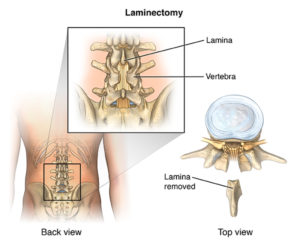A decompressive laminectomy or laminectomy is a surgical procedure that seeks to remove the bony arch of the vertebra that covers the nerve, known as the lamina. This technique allows relieving the pressure of the spinal nerves and spinal cord. It is a good option in the treatment of spinal stenosis and vertebral arthrodesis.

When is laminectomy necessary?
When non-invasive treatments fail, a laminectomy is necessary to relieve symptoms that intervene with daily life. Candidates for a laminectomy present:
-Constant back pain of severe magnitude.
-Difficulty to walk.
-Weakness or numbness in the legs.
-Incontinence.
These symptoms are characteristic of a narrowing of the spinal canal that puts pressure on the spinal cord. If this narrowing is located in the upper part of the spine (narrow cervical canal), surgeons should perform a cervical laminectomy. If it is located in the lower back (narrow lumbar duct), specialists recommend lumbar laminectomy.
Narrowing of the spinal canal causes disorders that include degenerative disc disease, spinal stenosis, disc herniation, osteophytes or spondylosis. In many cases, two or more of these conditions may occur together.
Cervical Laminectomy
It is a surgical intervention at the level of the neck, in its back. Scheduled removal of spinal canal sheets or any other soft tissue that may be causing compression on the spinal cord is performed.
The reasons for having a cervical laminectomy are varied, but mainly for treating pressures on spinal nerves in the neck and also as a method to stabilize the cervical spine.
Lumbar laminectomy
Lumbar laminectomy is also known as open lumbar decompression and is applied for degenerative disorders. Surgeons perform it to treat lumbar spinal stenosis.
It is a technique which aims to extract part of the bone above or below the nerve root in order to free up space. The procedure involves an incision of 5 to 12 cm in the midline of the back and when approaching the spine the laminectomy helps to reach the nerve roots.
It is the last resource used when non-invasive measures have failed: injections, medications, physiotherapy, etc.
5 Benefits of a laminectomy
The objective is to eliminate the symptoms of the narrowing of the spinal canal, such as pain, numbness, tingling and weakness. In other words, restore all nervous function.
After a laminectomy, the following benefits should be achieved:
1- Total or partial pain relief.
2- Decompression on the spinal cord and nerves. Strength does not completely return to normal, but weakness improves markedly.
3- Prevention of deterioration and abnormal movement of the spine.
4- Considerable reduction of medication intake.
5- General stabilization of the spine and prevention of new damage.
Risks
The laminectomy technique is quite safe and problems almost never occur. More than 90% of patients leave surgery without complications. However, in any surgical intervention, there will always be risks, these can be:
-Infection: In the wound and/or the bones of the spine.
-Presence of constant pain.
-Loss of sensitivity due to damage to the spinal nerve (with probabilities of occurrence of less than 1%).
-Sexual impotence
-Incontinence.
Even so, if this procedure is not performed in time, it can make the disease worse and start presenting problems with walking, maintaining balance and a gradual deterioration of motor functions.

